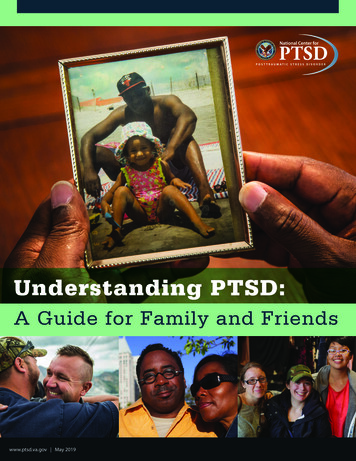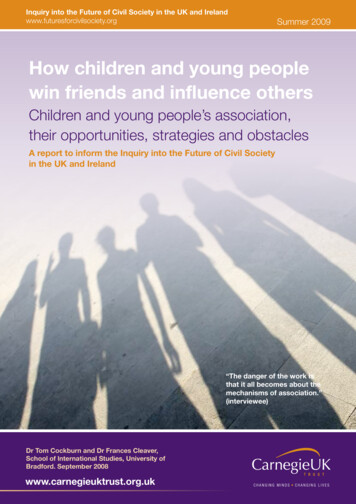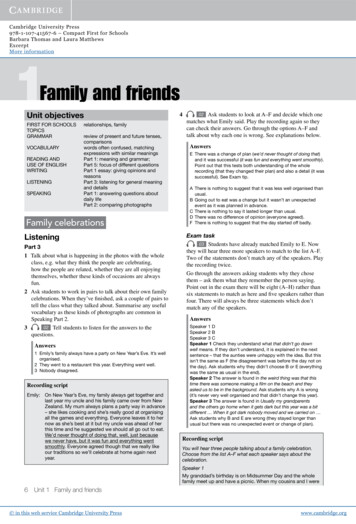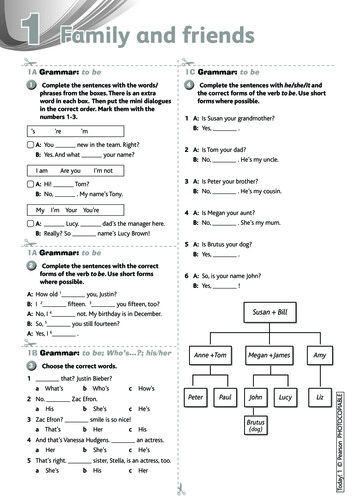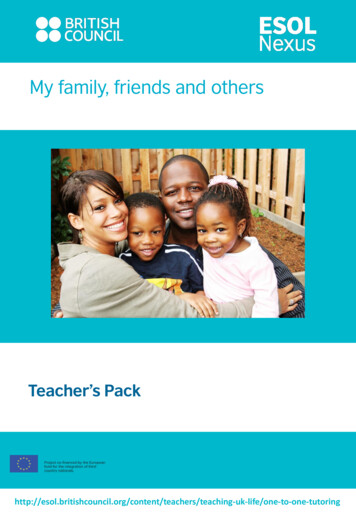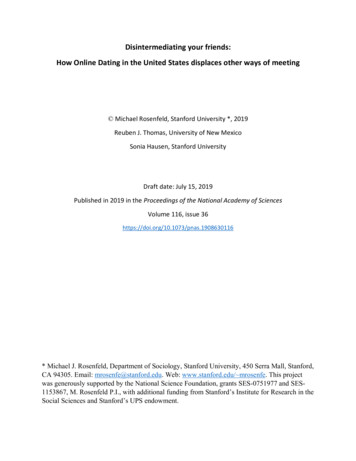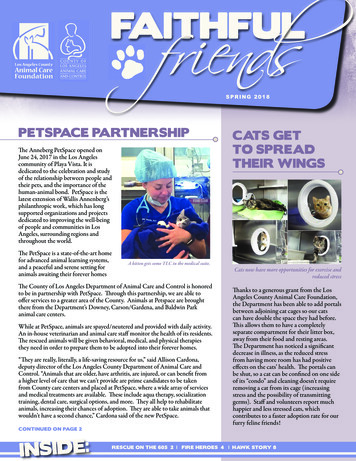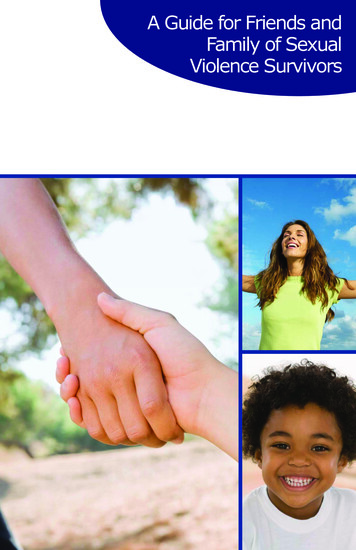
Transcription
A Guide for Friends andFamily of SexualViolence Survivors1
A Guide for Friends& Family of SexualViolence SurvivorsIf you have experienced sexual violence and are seeking help or wouldlike more information, call 1-888-772-7227 in Pennsylvania, or call theRape, Abuse & Incest National Network (RAINN) at 1-800-656-4673from anywhere in the U.S.
Table of ContentsImmediate concerns.1How you can help.3Responding to child sexual abuse.5Effects of the assault.7Understanding sexual violence.9Child sexual abuse.13Teen’s experience with sexual violence.14Male survivors of sexual violence.15Questions and answers.16What you can do to preventsexual violence.18Definitions.23
Immediate concernsThe period following a sexual assault is emotionally charged,confusing, and frightening. If you know someone who has beensexually assaulted, it is important to address the following topics:Physical safetyMake sure the person is in a safe place. Be there emotionallyfor them and encourage reaching out for additional support.Contact your local rape crisis center for free and confidentialcounseling and support or call the National Sexual Assault Hotlineat 1-800-656-4673 (HOPE).Medical attentionA medical exam can reveal injuries that may not be visible.Hospital staff can also provide treatment for possible sexuallytransmitted diseases (STDs), medication to prevent pregnancy(emergency contraception), and perform an exam to collectevidence if the assault happened within five days. Hospitals mayhave different policies around the time frame for an exam.1
Nearly 1 in 5women in theU.S. have beenraped at sometime in theirlives.Reporting the AssaultIf the victim goes to the hospital, thehospital will most likely report thecrime to the police. However, thevictim does not have to talk to thepolice in order to get a forensic exam.The victim can decide later whetheror not to talk to police. Victims olderthan 18 years old have 12 years toreport sexual assault in Pennsylvania. Victims younger than18 years old can report the abuse until they turn 50, or 32years after their 18th birthday regardless of when the abuseoccurred. Once a report to law enforcement has been made,the Commonwealth of Pennsylvania, through the countyprosecutor or district attorney’s office, can chose to file criminalcharges against the perpetrator. Even1 in 6 boysif report has been made, it is ultimatelyexperiencechildup to the prosecutor’s office to decidesexual abusewhether or not to move forward withbeforethe agea case. During the decision process,of 18, and 1 inthe prosecutor is evaluating: if the71 adult mencrime occurred; what can be chargedexperienceunder Pennsylvania's criminal law;rape.and whether or not the crime can beproven beyond a reasonable doubt.Counseling(Black et al., 2011,Dube et al., 2005)Victims and others in their life mayneed help dealing with feelings they experience after a sexualassault impacts their lives. Sexual assault is a serious crime, andis known to have short- and long-term effects on victims andthose who love and care for them. If you are a victim of sexualviolence seeking assistance or would like more information,please call 1-888-722-7227 in Pennsylvania or contact theRape, Abuse & Incest National Network (RAINN) at1-800-656-4673 from anywhere else in the United States.2
How you can helpEffective communication is important to a victim’s wellbeing. If you are wondering what you can do, here are somesuggestions: Remain calm. You may feel shocked or outraged, butexpressing these emotions to the victim may causeconfusion or discomfort. Believe the victim. Make it clear that you believe theassault happened and that the assault is not her or hisfault. Give the victim control. Control was taken away duringthe assault. Empower the victim to make decisions aboutwhat steps to take next, and try to avoid telling her or himwhat to do. Be available for thevictim to express a rangeof feelings: crying,screaming, being silent,etc. Remember, the victimis angry with the personwho assaulted her or himand the situation, not withyou. Just be there to listen. Assure the victim of yoursupport. She or he needsto know that regardlessof what happened, yourrelationship will remainintact.3
Avoid making threats against the suspect. Threats of harmmay only cause the victim to worry about your safety andrisk of arrest. Maintain confidentiality. Let the victim decide who to tellabout the assault. Encourage counseling. Give the victim the hotline numberfor the nearest rape crisis center, but let the victim decidewhether or not to call. Ask before offering physical support. Asking “Can I giveyou a hug?” can re-establish the victim’s sense of security,safety, and control. Say what you can guarantee. Don’t make promises youcan’t keep, such as saying the victim will never be hurtagain, or that the offender will be put in jail. Allow the proper authorities to deal with the assault.Confronting the person who committed the sexual assaultmay be harmful or dangerous. Attempting to investigateor question others who may know about the assault mayhamper a legal investigation. Leave this to the properauthorities. Be patient and recognize that healing can take years withadvances and setbacks. Take care of yourself. If you need support for yourself,please contact your local rape crisis center for aconfidential place to discuss your feelings.4
Responding to child sexual abuseThe disclosure of child sexual abuse can affect the entirefamily system. If you are a caregiver of a child who hassurvived sexual abuse, you may want to seek supportfrom family, friends, or a counselor at your local rapecrisis center. You may even want to connect with othercaregivers who are going through a similar experience. Ifyou are able to work through your own feelings, you willbe better able to support your child.You may be experiencing many emotions right now. Oftencaregivers will have feelings of anger, sadness, and guiltabout what has happened to their child. You may haveclear feelings of anger at the person who abused yourchild, or you may feel confused, especially if the personwho abused your child is also someone that you love andtrust.Recognize your own feelings; they are most likely verynormal. Also know that your child may have differentfeelings than you, and that is okay. Let your child knowthat their feelings are also normal and that there are manyways to safely express these feelings.Effects of child sexual abuse may be similar to thosereactions experienced by adults after a sexual assault,found on the next page. Changes in behavior are perhapsthe most important thing to note in children, since this ishow they communicate. Children may have nightmares,difficulty sleeping, trouble concentrating, display regressivebehavior such as thumb sucking or bed wetting, or a dropin grades at school.5
Caring for a child after a disclosure of sexual abuse canbe challenging. The disclosure of sexual abuse createsa crisis for many families. Caregivers may assume thatonce a child has disclosed that they will feel safe andreturn to normal functioning. While children are veryresilient and can heal from this abuse, healing takestime and patience.The following are some things you can do to help: Maintain consistent rules and structure to increasefeelings of safety. Give choices whenever possible to allow a greatersense of control. Allow them to have ALL feelings and expressthese feelings in a safe way. Recognize their strengths and help them to seetheir own resilience. Listen, believe, and support them-your support ismore important than anything else right now.6
Effects of the assaultEach survivor reacts to sexual violence in her or his ownunique way, such as: Expressing emotions or preferring to keep their feelingsinside. Talking about the assault soon after or waitingweeks, months, or even years before discussing theassault, if they ever choose to do so. Experiencing physical responses to the trauma as aneffect of the assault. Developing coping mechanisms that could be harmfulor unhealthy such as drug and alcohol use or self-injury,or healthy and therapeutic options such as journaling,expression through art and seeking therapy. Somesurvivors will display a mix of healthy and unhealthy waysof coping.It is important to respect each person’s choices and style ofcoping with this, and any, traumatic event. You can help byoffering to connect victims with the services of a rape crisiscenter where staff are experienced in dealing with the effectsand responding without judgment. Whether an assaultwas completed or attempted, and regardless of whether ithappened recently or many years ago, it may impact dailyfunctioning. A wide range of reactions can impact victims,both immediately after the assault and for days or years afterthe assault.Post-Traumatic Stress Disorder, injury or other short- and longterm effects have been reported by 81% of women and 35%of men who experienced rape, stalking or physical violence byan intimate partner. (Black, et. al., 2011)7
Reactions to sexual assaultEmotional Guilt, shame,self blame Embarrassment Fear, distrust Sadness Isolation Lack of control Anger Numbness Confusion Shock,disbelief DenialPsychological Nightmares Flashbacks, orre-experiencingthe assault Dissociation Depression andother mooddisorders Difficultyconcentrating Post-TraumaticStress Disorder(PTSD) Anxiety Substance useor abuse Phobias or fears Low self-esteem Thoughts of selfharm, includingsuicide.Physical Nightmares Flashbacks, orre-experiencingthe assault Dissociation Depression andother mooddisorders Difficultyconcentrating Post-TraumaticStress Disorder(PTSD) Anxiety Substance useor abuse Phobias or fears Low self-esteem Thoughts of selfharm, includingsuicide.The human body and brain are very resilient. Many victims fullyrecover from the emotional, physical, and psychological effectsof the assault. For most, talking through the trauma is a key tohealing.Free and confidential counseling is available through local rapecrisis centers. A list of rape crisis centers in Pennsylvania can befound at www.pcar.org. Outside of Pennsylvania, please visithttp://www.rainn.org/ or call 1-800-656-4673.8
Understanding sexual violencePeople whoperpetratesexual assaultoften usecoercion,manipulation, or“charm.” In somecases, theymay use force,threats, or injury.The lack ofphysical injuriesto the victimdoes not indicatethe victim’sconsent.Sexual violence is any type ofunwanted sexual contact. This caninclude words and actions of a sexualnature.Sexual violence can be committedwithout the knowledge of theperson harmed. For example, severalfactors can interfere with a person’sknowledge that sexual violence hasbeen committed against them: age,cognitive disabilities, mental illness,incapacitation due to drugs and/oralcohol, and others.Some forms of sexual violencemay not be illegal, such as sexistand sexually violent jokes, street sexualharassment and catcalling but this doesnot make them any less threatening orharmful to the person victimized.9
There are many forms of sexual violence, including but notlimited to: Child sexual abuse (see page 12 for a definition) Commercial sexual exploitation, including prostitution andhuman trafficking Exposure and voyeurism Forced participation in the production or viewing ofpornography Incest Rape– whether the victim knows the perpetrator slightly,casually, intimately, or not at all Ritual abuse Sexual harassment Sexual or gender-based bullying, including cyber-bullyingThe majority of sexual violence is committed by someone thevictim knows. They can include: Caregivers Classmates Family members Friends and neighbors Healthcare providers Members and leaders of faith communities Partners Teachers and coachesMore than half (51%) of female victims of rape reported beingraped by an intimate partner and 41% by an acquaintance; formale victims, more than half (52%) reported being raped by anacquaintance and 15% by a stranger (Black et al., 2011).Persons victimized by sexual violence can be any age orgender, but children and teens are at the highest risk. Peoplemay experience more than one sexual assault during theirlives. They may also face other forms of violence and socialstruggles.10
Sexual violence can occur in any setting, including but notlimited to: Faith communities Residential care facilities Healthcare facilities Schools and childcare Homesprograms Party or other social Teams and othereventsorganized recreational Prisons and otheractivitiescorrectional facilities WorkplacesSexual violence is sometimes covered up by institutionsor people in positions of authority. Sexual violence issometimes ignored or allowed to continue even after it isdiscovered by family members, friends, or other communitymembers.Oppression is a root cause of sexual violence. Sexualviolence is tied to inequality. People who commit sexualviolence may target people who may have less perceivedpower in society due to factors such as (but not limited to): Age Political identity Disability Race or ethnicity Gender identity Religious or spiritual Immigration statusbeliefs Income Sexual orientation11
Inequality can result in people having less access to informationand resources. This can make it hard for a person to reportsexual assault or get help.Sexual violence affects everyone: individuals, families,communities, and the larger society. Sexual violenceoften impacts an individual’s education, employment andincome, housing and shelter, and physical and mental health.Relationships with friends and family members may beimpacted.Sexual violence can be prevented. Community memberscan work to prevent sexual violence by establishing healthyand positive relationships that are based on respect, safety,and equality. Community members can play an active role instopping sexual violence before it occurs by becoming engagedbystanders. Sexual violence affects us all; therefore, we are all apart of the solution.12
Child sexual abuseChild sexual abuse is physical or visual contact betweenan adult, teen, or another child and a child that results insexual stimulation and gratification for the adult or minor.Child sexual abuse is often a gradual process, with the adultdeliberately testing a child’s boundaries using his or herfamiliarity with the child, social status, or power. This process iscalled “grooming” and often happens by building trust, givinggifts or favors, separating the child from others, creating anorm of secrecy for other activities, and violating boundaries.The adult will continue to act in this manner and perpetratesexual acts upon the child. This may go on for years, andthe child may never tell anyone about the abuse due to thecoercive behaviors, feeling of love, dependence, and/or fear forthe adult.The majority of sexual victimization starts earlyin life. Approximately 80% of female victims experiencedtheir first rape before the age of 25 and almost halfexperienced the first rape before age 18 (30% between11-17 years old and 12% at orbefore the age of 10). About 35% of women who wereraped as minors were also raped asadults compared to 14% of womenwithout an early rape history. 28% of male victims of rape werefirst raped when they were 10 yearsold or younger. (Black et al., 2011)13
Teens’ experience with sexualviolenceSexual violence can happen at any age, but research has foundthat young adults might be at higher risk.Sexual violence and datingDuring a large research online study, 45% of girls said theyknow a friend or peer who has been pressured into havingeither vaginal or oral sex (Futures Without Violence, 2010).Technology and abusePressure from a dating partner or even friends can be a reasonto send sexy images or messages – 51% of young womenwho took a survey said they felt a lot of pressure from a guythey liked or were dating to send sexual pictures or texts (TheNational Campaign to Prevent Teen and Unplanned Pregnancyand CosmoGirl.com, 2008).14
Sexual harassmentSexual harassment could include verbal harassmentlike unwelcome comments about a person’s body andinappropriate jokes. Harassment can also be online or virtualthrough texts, social networking sites, or by other electronicsources. Almost half of students in a nationally representativesurvey said they had experienced some form of sexualharassment at school (Hill & Kearl, 2011).Male survivors of sexual violenceA national study found that 1 in 71 adult men reported beingraped (Black et al., 2011). In addition, one in six boys willexperience child sexual abuse before the age of 18 (Dubeet al., 2005). The same study found that 6% of men haveexperienced sexual coercion and 11% reported unwantedsexual contact at some point in their lives.15
Questions and answersA: Each person who experiencessexual violence reacts differently.Some survivors respond byengaging in a lot of sexual activitywith many partners while othersstop all sexual activity. Eachof these are normal, commonreactions to the traumatic event,but your concerns are valid. Herresponse may take an emotionaltoll on both you and yourdaughter.Q: Since she wasraped, my teenagedaughter has beenhaving sex a lot.Why is she behavinglike this? It doesn’tmake sense.The sexual assault impacted yourdaughter’s sense of control overher life and sexuality, and she may view sexual activity as a wayto re-gain control. Talking to a counselor about her experiencesmay help your daughter understand the link between theassault and her sexual choices. It may be helpful to also talk toyour daughter about how to stay safe during sexual activity.16
A: Most likely, yes. Higher levels ofstress caused by fear and dangerQ: My brother wasrelated to sexual violence cansexually abused ascause long-term effects to thea child. Now, as anbrain and can heighten the needadult, he abusesfor coping mechanisms, includingdrugs and alcohol. Isself medication. Research showsoverwhelming evidence that victimsthere a connection?of sexual violence are much morelikely to use alcohol and other drugsto cope with the trauma of theirvictimization. Drugs and alcoholproduce chemical changes to thebody every time they are used. They are a reliable, immediate wayto alter how a person is feeling. The short term relief provided byalcohol or drugs may also become problematic for many survivors.Victims of rape are 13 times more likely to develop two or morealcohol-related problems and 26 times more likely to have two ormore serious drug abuse-related problems (Kilpatrick & Aciemo,2003). Drugs and alcohol are fast acting, socially accepted,available, and cheap ways to make the symptoms of trauma goaway, at least for a short time. The problem is that drugs andalcohol are addictive, meaning people need more and more tomaintain the effects, and using drugs and alcohol can increase therisk of experiencing additional violence because many offenderssee intoxication as a vulnerability to exploit. If your brother isthinking about or in treatment for addiction, it may be helpfulto encourage him to also talk to someone about the abuse heexperienced. Often, when sober, the effects of trauma comerushing back to survivors and can lead to relapse.17
What you can do to preventsexual violenceCreate safe communities for childrenIt is important for adults to feel confident in their ability toprotect children from violence. Children are not responsiblefor protecting themselves or avoiding sexual abuse. Parents,guardians, educators, and other adults can create safecommunities for all children by: Becoming comfortable talking with the childrenin their lives about their bodies and physicaldevelopment, respecting when a child does notwant to give or receive physical affection such as ahug, kiss, or “high-five” – even if it is from a familymember. Practicing action steps when another adult actsinappropriately with a child or children (such asinsisting on spending time alone with a child or notrespecting the child’s boundaries). Knowing what support is available if they think abuseis happening. Reaching out forhelp when theysuspect any formof abuse againsta child.18
We can all help create respectful, healthy, and safe places forchildren. You can make your community a better place foreveryone.If a child shares abuse with you or you suspect that achild is being abused, this may be information that youare required to report. You may also wish to make a reportsimply because you care about the safety and well-beingof children. For information on reporting child abuse andneglect in your state go to Child Welfare InformationGateway at www.childwelfare.gov or call The ChildhelpNational Child Abuse Hotline 1-800-4-A-CHILD (1-800-4224453).19
Create safe communities for everyoneEvery person has the ability to promote and share respectfulbehaviors. This can be as simple as privately asking afriend not to make inappropriate comments or as public asintervening during an argument or conflict. Taking action insome way, shape, or form begins to change the thoughts orbeliefs or norms of a community.For example, a friend of your family makes “jokes” orcomments about a highly-publicized case of sexual assault.They imply the victim is at fault. In this situation, you could: Share the information you know about sexualviolence and say that sexual assault is always achoice made by the perpetrator, and victims arenever at fault. Ask compassionate and thoughtful questions aboutthe person’s attitude. Why do they feel that way?Maybe having a discussion could change theirattitude or belief. Tell them those comments are not appreciated inyour home/workplace/presence and you wouldappreciate it if they stop.20
These small, but long-reaching, actions can create tremendouschange. We start the wheels of change when we dosomething that interrupts or brings attention to somethingpeople see as “normal” or accepted. People who commitsexual violence rationalize their actions with belief in inequalityand oppressive attitudes and systems – changing theseattitudes and systems can begin to bring about an end tosexual violence.21
Encourage healthy relationships and interactionsMany of the messages we receive from media are violent,manipulative, or harmful to both young women and youngmen. It is important to think carefully about these images andstories so that you can create healthy relationships and sexualexperiences.Consent means both people actively agree with what they aredoing together. It is a mutual decision that both people makewithout any coercion or force. Consent is best recognizedwhen it is verbal and when it shows a “yes” (or something like“sure” or “please”).Some ways you can practice consent: Ask the other person if they are comfortable whenyou are in a sexual or romantic situation. Thisdoesn’t have to be formal or stuffy, a simple “Areyou OK with this?” works just fine. Wait for a verbal “Yes” (or clear body languagelike nodding their head that tells you they feelgood about the situation). Silence, a “No,” orphysically resisting means things need to stop. Answer honestly and verbally when someone asksyou for consent. They might not know about thiskind of consent, so have a conversation ahead oftime. Again, it doesn’t have to be a big deal, justa simple request between two people who respectand like each other.22
DefinitionsConsentConsent means both people actively agree with what they aredoing together. It is a mutual decision that both people makewithout any coercion or force. Consent is best recognized when itis verbal and when it shows a “yes” (or something like “sure” or“please”).DissociationThose who were forced to undergo traumatic sexual abuse can findthe experience too much to bear. Since the victim was preventedfrom leaving the assault physically, the only remaining option wasmental escape (dissociation). Victims often describe it as “floatingabove themselves” or concentrating intently on a particular objectin the room. Survivors may continue this behavior throughouttheir lives and in times of stress, may “space out,” or go numb.Dissociation is a normal response to victimization, but somesurvivors may find it disruptive in their daily lives and can seek helpto learn to manage it.Engaged BystanderAn engaged bystander is someone who intervenes before, during,or after a situation when they see or hear behaviors that promotesexual violence. It is common for people to witness situationswhere someone makes an inappropriate sexual comment orinnuendo, tells a rape joke, or touches someone in a sexual manner.Bystanders may also witness other forms of sexual violence.Bystanders who witness the behavior or hear the comment canintervene in a positive way that will help create a safer environment.23
FlashbacksA flashback is a complete re-experiencing of the sexual assault. It ismore than a memory — the survivor actually believes the trauma isoccurring right now, all over again. They are reliving the experience.Often, victims are unable to distinguish the past from the present, afriend, or loved one from the person who assaulted them. This is avery scary experience, and they may need your help in re-establishingtheir sense of safety in the present.GroomingA gradual process where a perpetrator will deliberately test aperson’s boundaries using his or her familiarity, social status, orpower to take advantage of the person. Grooming often happensby building trust and familiarity, giving gifts or favors, separatingthe person from others (such as care providers, friends, etc.), andviolating boundaries. Grooming with children often also includes agradual process of normalizing secrecy, including for sexual activities.OffenderThere are a lot of misconceptions and stereotypes about people whosexually abuse, however we know these stereotypes do not tell thereal story. In general, here are some facts about people who offend: People who sexually abuse can be male or female, and span avariety of backgrounds and ages. Some individuals are marriedwith stable relationships, employment, and lack a criminal history.They can have strong social ties in the community. The majority of sexual violence is committed by someone thevictim knows — a family member, intimate partner, coworker,classmate, or acquaintance. Not all offenders are the same. Someare more likely to reoffend than others, and there are differentmotivations for offending.Most people who commit sexual offenses begin their offendingbehaviors during adolescence. Additionally, intervention andtreatment is more likely to be successful when it happens early. Forthese reasons, it is important to address sexual violence committedby youths as well as by adults.24
Post-Traumatic Stress DisorderPost-traumatic stress disorder, or PTSD, is a psychiatric disorder thatcan occur following the experience or witnessing of life-threateningevents such as military combat, natural disasters, serious accidents,or violent personal assaults like rape.According to the American Psychiatric Association, a persondiagnosed with PTSD experiences the following:1. A traumatic event that involved a serious threat of injury ordeath and a response of extreme fear2. The unwelcome re-experiencing of the event3. An effort to avoid things associated with the event4. Persistent symptoms of arousal (irritability, difficultyconcentrating and/or falling/staying asleep, etc.)5. The above symptoms for a month or more6. The above symptoms that cause noticeable strain at work, inrelationships, and/or other areas of life.TriggersTriggers are specific touches, sights, sounds, smells, places, etc.,that involuntarily evoke a memory of the sexual assault. Triggersoften lead to painful flashbacks. Victims often take conscious orunconscious steps to avoid triggers such as avoiding certain places,kinds of music, foods, smells, etc. Doing so means the victim isforced to limit her or his life activities.Victim vs. survivorThroughout this guide, the terms “victim” and “survivor” are usedinterchangeably to be inclusive of the various ways people who haveexperienced sexual violence may identify. The Pennsylvania CoalitionAgainst Rape (PCAR) recognizes and supports the use of personfirst terminology that honors and respects the whole person, whichis also reflected in this guide. Individuals may ultimately choose thelanguage that is used to describe their experiences and therefore,supports advocacy approaches that are person-centered and that usethe terminology preferred by individuals they serve.25
ReferencesBlack, M. C., Basile, K. C., Breiding, M. J., Smith, S. G.,Walters, M. L., Merrick, M. T., Stevens, M. R. (2011).The National Intimate Partner and Sexual ViolenceSurvey (NISVS): 2010 summary report. Retrieved fromthe U.S. Department of Health and Human Services,Centers for Disease Control and Prevention, National Centerfor Injury Prevention and Control: http://www.cdc.gov/ViolencePrevention/pdf/NISVS Report2010-a.pdfFutures Without Violence. (2010). Emerging issuesfacing tweens and teens. Retrieved from le/Teens/EmergingIssues Facing Teens and Tweens FINAL.pdfHill, C., & Kearl, H. (2011). Crossing the line: Sexualharassment at school. Retrieved from the AmericanAssociation of University Women: e-Sexual-Harassment-atSchool.pdfKilpatrick, D. G.
A Guide for Friends & Family of Sexual Violence Survivors If you have experienced sexual violence and are seeking help or would like more info
